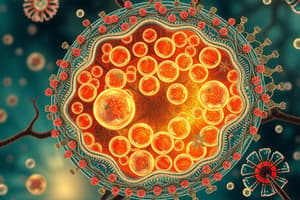Podcast
Questions and Answers
What is the main function of the cell membrane?
What is the main function of the cell membrane?
- To generate energy for the cell
- To synthesize proteins and lipids
- To control what enters and leaves the cell (correct)
- To provide structural support to the cell
What is the main component of the cell membrane?
What is the main component of the cell membrane?
- Nucleic acids
- Carbohydrates
- Phospholipid bilayer (correct)
- Proteins
Which organelle is responsible for generating energy for the cell?
Which organelle is responsible for generating energy for the cell?
- Golgi Apparatus
- Mitochondria (correct)
- Endoplasmic Reticulum
- Nucleus
What is the function of the Golgi Apparatus?
What is the function of the Golgi Apparatus?
Which type of organelle lacks a distinct membrane?
Which type of organelle lacks a distinct membrane?
What is the function of the Endoplasmic Reticulum (ER)?
What is the function of the Endoplasmic Reticulum (ER)?
Flashcards are hidden until you start studying
Study Notes
Cell Structure
Cell Membrane
- Semipermeable: allows certain substances to pass through while keeping others out
- Phospholipid bilayer: composed of two layers of phospholipid molecules with hydrophilic (water-loving) heads and hydrophobic (water-fearing) tails
- Functions:
- Controls what enters and leaves the cell
- Provides structural support and maintains cell shape
- Regulates cell signaling and communication
Organelles
Types of Organelles
- Membrane-bound organelles:
- Have a distinct membrane separating them from the rest of the cell
- Examples: nucleus, mitochondria, endoplasmic reticulum, Golgi apparatus
- Non-membrane-bound organelles:
- Lack a distinct membrane
- Examples: ribosomes, cytoskeleton
Organelle Functions
- Nucleus:
- Controls cell growth and division
- Contains genetic material (DNA)
- Mitochondria:
- Generates energy for the cell through cellular respiration
- Converts glucose into ATP
- Endoplasmic Reticulum (ER):
- Synthesizes and transports proteins and lipids
- Two types: rough ER (with ribosomes) and smooth ER (without ribosomes)
- Golgi Apparatus:
- Modifies and packages proteins and lipids for transport
- Forms lysosomes and secretory vesicles
- Ribosomes:
- Site of protein synthesis
- Found throughout the cytoplasm and attached to ER
- Cytoskeleton:
- Provides structural support and shape to the cell
- Involved in cell movement and division
Cell Structure
- Cell membrane is semipermeable, allowing certain substances to pass through while keeping others out.
- Phospholipid bilayer structure: two layers of phospholipid molecules with hydrophilic (water-loving) heads and hydrophobic (water-fearing) tails.
- Cell membrane functions: controls what enters and leaves the cell, provides structural support and maintains cell shape, and regulates cell signaling and communication.
Organelles
Types of Organelles
- Membrane-bound organelles: have a distinct membrane separating them from the rest of the cell.
- Examples of membrane-bound organelles: nucleus, mitochondria, endoplasmic reticulum, Golgi apparatus.
- Non-membrane-bound organelles: lack a distinct membrane.
- Examples of non-membrane-bound organelles: ribosomes, cytoskeleton.
Organelle Functions
- Nucleus functions: controls cell growth and division, contains genetic material (DNA).
- Mitochondria functions: generates energy for the cell through cellular respiration, converts glucose into ATP.
- Endoplasmic Reticulum (ER) functions: synthesizes and transports proteins and lipids, has two types: rough ER (with ribosomes) and smooth ER (without ribosomes).
- Golgi Apparatus functions: modifies and packages proteins and lipids for transport, forms lysosomes and secretory vesicles.
- Ribosomes functions: site of protein synthesis, found throughout the cytoplasm and attached to ER.
- Cytoskeleton functions: provides structural support and shape to the cell, involved in cell movement and division.
Studying That Suits You
Use AI to generate personalized quizzes and flashcards to suit your learning preferences.




